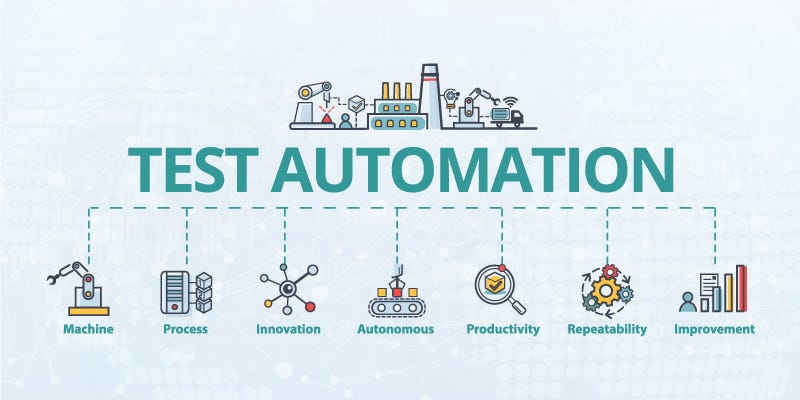Guaranteeing Success in Automation Evaluating: Key Metrics, Challenges, and Solutions Every QA Group Ought To Know
In the realm of software top quality guarantee, the landscape of automation screening is ever-evolving, requiring a precise approach to guarantee seamless procedures. Key metrics offer as the compass leading QA teams via the huge terrain of examination automation, clarifying progression and areas for improvement. Nevertheless, challenges loom big, frequently casting darkness on the path to success. By understanding these obstacles and applying effective remedies, QA teams can browse through intricacies with finesse. The journey to understanding automation testing is led with nuances that require an eager eye for monitoring, evaluation, and continual renovation. automation testing. As the industry pushes onward, the pursuit for optimum efficiency in automation screening continues to be a consistent search, prompting QA groups to outfit themselves with the knowledge and techniques necessary for victory.
Value of Secret Metrics
Comprehending the significance of essential metrics is vital for examining the performance and performance of automation screening processes. Trick metrics serve as quantifiable steps that supply beneficial insights into various aspects of the screening procedure, such as examination protection, test implementation time, issue thickness, and test case performance. By examining these metrics, QA teams can recognize bottlenecks, inefficiencies, and locations for improvement within their automation testing structure.
One vital element of vital metrics is their capacity to track development and keep track of the overall health and wellness of the testing process (automation testing). They allow stakeholders to make informed choices based on data-driven insights, which can lead to a lot more efficient testing strategies and much better source allowance. Additionally, crucial metrics can help groups set realistic objectives, gauge the success of automation campaigns, and demonstrate the ROI of automation screening efforts

Common Challenges Encountered
Difficulties typically encountered in automation screening procedures can considerably impact the total effectiveness and effectiveness of QA groups. One of the significant obstacles is the choice of the right examination situations for automation. Not all examination situations appropriate for automation, and picking the wrong ones can lead to lost time and resources. In addition, preserving examination manuscripts can be a difficult task, specifically as the application goes through frequent adjustments. Test manuscript maintenance calls for constant updates and alterations to ensure they mirror the present functionality properly. One more common obstacle is the initial financial investment needed for setting up automation structures and tools. This can be an obstacle for some organizations, especially smaller sized ones with restricted spending plans. Automation screening may not cover all facets of testing, such as functionality and user experience screening, which still require hands-on intervention. Getting over these difficulties requires correct planning, critical test instance selection, durable maintenance procedures, adequate sources, and a clear understanding of the limitations of automation testing.
Efficient Solutions for Obstacles
To deal with the barriers come across in automation testing, implementing reliable options is necessary for improving the efficiency and performance of QA groups. One essential solution is to spend in robust training programs for QA teams to guarantee they have the required skills to properly use automation tools. Training can link understanding gaps, boost understanding of automation frameworks, and enhance scripting capacities, eventually leading to more reliable examination creation and implementation.
An additional vital option is to establish clear communication channels within the QA team and with various other stakeholders, such as designers and project managers. Efficient interaction aids in lining up assumptions, sharing progression updates, and promptly addressing problems or obstructions that might occur during the automation testing process.

Tracking and Analysis Strategies
Carrying out efficient monitoring and evaluation methods is essential for ensuring the success and performance of automation testing processes. By using monitoring devices, QA teams can track the efficiency of examination scripts, recognize bottlenecks, and determine locations for improvement. Real-time surveillance enables for fast detection of concerns, making it possible for fast reaction and resolution. In addition, assessing examination results and metrics gives useful insights into the top quality of the software being examined and the efficiency of the screening technique.
One trick technique in tracking and evaluation is using dashboards that combine pertinent metrics and KPIs in an aesthetically available style. These control panels offer an extensive introduction of examination implementation status, test protection, flaw fads, and other crucial info. On a regular basis reviewing and assessing these control panels can help QA teams make informed decisions, prioritize tasks, and optimize testing efforts.
Additionally, executing automated notifies and notices based on predefined thresholds can improve positive tracking and timely intervention. By setting up notifies for performance discrepancies or test failures, teams can address issues promptly and prevent them from escalating. Overall, monitoring and analysis techniques play a vital role in guaranteeing the effectiveness and success of automation testing initiatives.
Continuous Enhancement Methods
Enhancing the efficiency of automation screening procedures demands the consistent refinement of techniques and approaches. Continual renovation approaches are crucial for QA groups to adjust to progressing innovations and deliver top quality software. One vital technique to enhancing automation screening procedures is to conduct normal evaluations important site and retrospectives. By evaluating past screening cycles, groups can identify traffic jams, inefficiencies, and locations for enhancement. Implementing responses loops and incorporating lessons found out into future screening frameworks can generate substantial renovations in time.

Conclusion
In verdict, it is vital for QA teams to understand the key metrics, obstacles, and services in automation screening to make sure success. By thoroughly monitoring and examining data, carrying out effective options to common obstacles, and continuously enhancing techniques, QA groups can optimize their screening processes and provide high-quality software application products. Sticking to these practices will inevitably lead to a lot more reliable and efficient automation screening practices.
By examining these metrics, QA teams can identify traffic jams, ineffectiveness, and locations for Visit This Link renovation within their automation screening structure.
Additionally, essential metrics can assist groups established reasonable goals, gauge the success of automation campaigns, and demonstrate the official site ROI of automation testing efforts.
Difficulties commonly run into in automation screening procedures can substantially affect the total performance and effectiveness of QA teams. Automation testing may not cover all elements of screening, such as functionality and customer experience screening, which still call for hand-operated intervention.In conclusion, it is important for QA teams to comprehend the crucial metrics, obstacles, and remedies in automation screening to make certain success.
Comments on “Reliable Automation Testing: Enhancing Software Program Integrity and Rate”